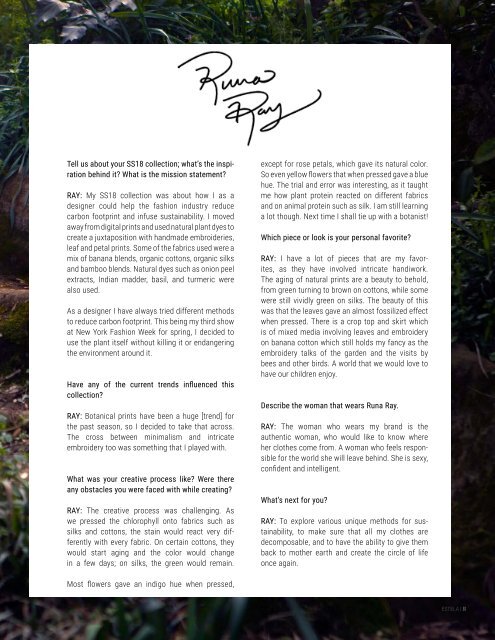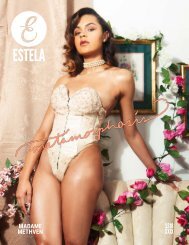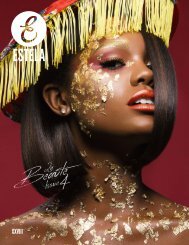Estela Magazine: Issue XXIX Cover 2
SS18 Fashion Issue | Cover 2 featuring Runa Ray Issue XXIX www.estelamag.com @estelamag
SS18 Fashion Issue | Cover 2 featuring Runa Ray
Issue XXIX
www.estelamag.com
@estelamag
You also want an ePaper? Increase the reach of your titles
YUMPU automatically turns print PDFs into web optimized ePapers that Google loves.
Tell us about your SS18 collection; what’s the inspiration<br />
behind it? What is the mission statement?<br />
RAY: My SS18 collection was about how I as a<br />
designer could help the fashion industry reduce<br />
carbon footprint and infuse sustainability. I moved<br />
away from digital prints and used natural plant dyes to<br />
create a juxtaposition with handmade embroideries,<br />
leaf and petal prints. Some of the fabrics used were a<br />
mix of banana blends, organic cottons, organic silks<br />
and bamboo blends. Natural dyes such as onion peel<br />
extracts, Indian madder, basil, and turmeric were<br />
also used.<br />
As a designer I have always tried different methods<br />
to reduce carbon footprint. This being my third show<br />
at New York Fashion Week for spring, I decided to<br />
use the plant itself without killing it or endangering<br />
the environment around it.<br />
Have any of the current trends influenced this<br />
collection?<br />
RAY: Botanical prints have been a huge [trend] for<br />
the past season, so I decided to take that across.<br />
The cross between minimalism and intricate<br />
embroidery too was something that I played with.<br />
What was your creative process like? Were there<br />
any obstacles you were faced with while creating?<br />
RAY: The creative process was challenging. As<br />
we pressed the chlorophyll onto fabrics such as<br />
silks and cottons, the stain would react very differently<br />
with every fabric. On certain cottons, they<br />
would start aging and the color would change<br />
in a few days; on silks, the green would remain.<br />
except for rose petals, which gave its natural color.<br />
So even yellow flowers that when pressed gave a blue<br />
hue. The trial and error was interesting, as it taught<br />
me how plant protein reacted on different fabrics<br />
and on animal protein such as silk. I am still learning<br />
a lot though. Next time I shall tie up with a botanist!<br />
Which piece or look is your personal favorite?<br />
RAY: I have a lot of pieces that are my favorites,<br />
as they have involved intricate handiwork.<br />
The aging of natural prints are a beauty to behold,<br />
from green turning to brown on cottons, while some<br />
were still vividly green on silks. The beauty of this<br />
was that the leaves gave an almost fossilized effect<br />
when pressed. There is a crop top and skirt which<br />
is of mixed media involving leaves and embroidery<br />
on banana cotton which still holds my fancy as the<br />
embroidery talks of the garden and the visits by<br />
bees and other birds. A world that we would love to<br />
have our children enjoy.<br />
Describe the woman that wears Runa Ray.<br />
RAY: The woman who wears my brand is the<br />
authentic woman, who would like to know where<br />
her clothes come from. A woman who feels responsible<br />
for the world she will leave behind. She is sexy,<br />
confident and intelligent.<br />
What’s next for you?<br />
RAY: To explore various unique methods for sustainability,<br />
to make sure that all my clothes are<br />
decomposable, and to have the ability to give them<br />
back to mother earth and create the circle of life<br />
once again.<br />
Most flowers gave an indigo hue when pressed,<br />
ESTELA | 81





